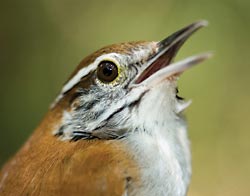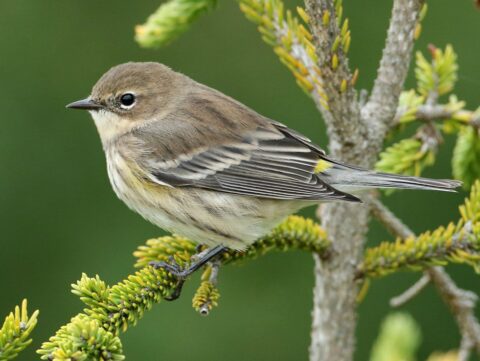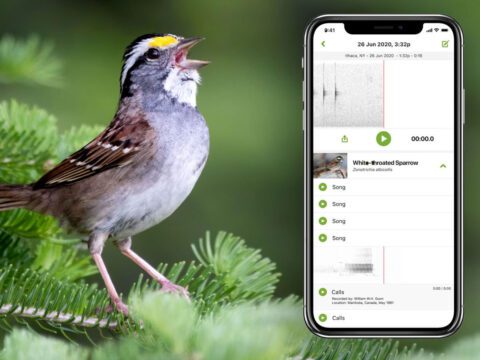It Takes Two: Bird Duets
By Laura Erickson; Photographs by Dale Morris
January 15, 2009
Teasing out the hows and whys of avian duetting
Duetting—breeding partners combining their two songs into one “song”—is one of the most complex vocal performances among all animals. In many tropical species, duetting can be so seamless that it can be hard to realize that more than one bird is singing.
Duetting is far more complex in birds residing year-round in the tropics than in their relatives breeding in temperate areas. The Carolina Wren, in the genus Thryothorus, sings a primitive duet—the male sings the familiar tea-kettle, tea-kettle, tea-kettle, and occasionally, without any discernable pattern in timing or frequency, the female chimes in with a buzzy phrase.
Tropical wrens in that genus sing far more complex duets, but studying their song behavior presents thorny problems, literally. Dense tropical vegetation makes observations of active birds separated by an average of 60 feet difficult at best.
Sandra Vehrencamp of the Cornell Lab of Ornithology collaborated with Daniel Mennill of the University of Windsor to devise two ingenious technological innovations for studying duetting Rufous-and-white Wrens in Costa Rica. First, they mapped out territories of 19 color-banded pairs the old-fashioned way, by visually tracking each pair for a month. Then they set up an array of eight omnidirectional microphones within each territory. The microphones were spaced about 150 feet apart, and recorded simultaneously onto eight channels of a sound file on a laptop computer. An acoustic location system triangulated the positions of the moving birds by the differences in each sound’s arrival time at each microphone.
By recording the wrens in a natural context, they learned that the space between a duetting pair ranged from about 15 inches to 475 feet. During duets, birds were more likely to approach their partner than to move away, and whichever of the pair sang the first part of the duet was the one who moved the bigger distance. In their 2008 report inCurrent Biology, the authors comment that “One individual sings, listens for a response from its partner, and moves toward its partner after hearing a response,” reminding them of the children’s game “Marco Polo.” They conclude that the first bird to sing is requesting information about where its mate is. Duetting is most common in the early part of the reproductive period and immediately after predation on eggs or nestlings, when the birds must renest, so may also serve a pair-bonding function.
The second part of the experiment was to find out how birds reacted to “playback”—hearing recordings of their own species near and on their territory. What sounds to our ears like a single Rufous-and-white Wren song usually comes from two different birds, so to simulate duets in a spatially realistic way, the researchers devised a dual-speaker playback system in which each speaker played either a solo or one bird’s part of a duet. They studied responses of territorial birds to four different sets of playback songs: male solos, female solos, duets in which the female sang first, and duets in which the male sang first. No matter which playback set was played, the territorial male sang significantly more than when no playback was involved, and most of his songs were solos. Females sang most of their solos in response to playback female solos and duets in which the female sang first. Females often joined in their mate’s song to create a duet no matter which playback was played.

A pair of wrens seems to use duets to coordinate their response to a perceived territorial intrusion, because during playback, duetting wrens sang closer together than without playback. There also appears to be a mate-guarding component, because males approached the loudspeakers more than females did, and approached the speaker playing the male song significantly more than they approached the one playing the female song; the less-territorial females were less likely to approach either speaker, but approached the one playing the female song more than the other.
Sandra notes, “Rufous-and-white Wren duets are especially beautiful, as the two birds overlap their flute-like notes. The pitch of the female’s song is higher than the male’s so they sing in harmony.” Using their innovative array of microphones to track where singing birds are and dual-speaker playback, the authors give us a glimpse into the rich complexities of not only the sound components of duetting vocalizations, but also their meanings.
Originally published in the January 2009 issue of BirdScope.

All About Birds
is a free resource
Available for everyone,
funded by donors like you
American Kestrel by Blair Dudeck / Macaulay Library



